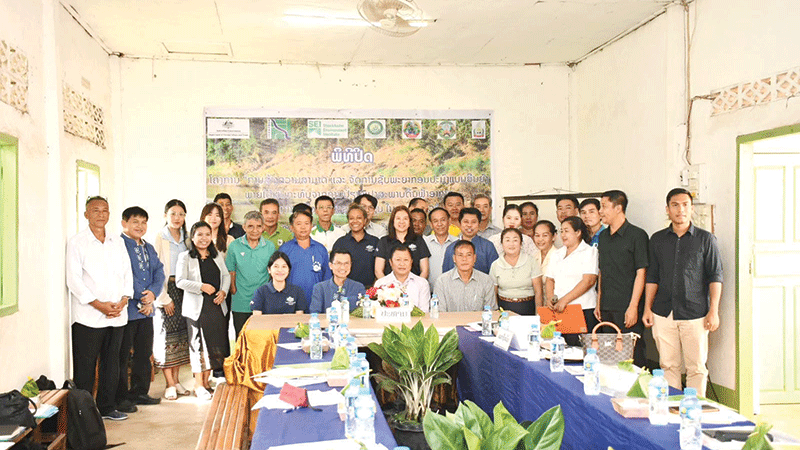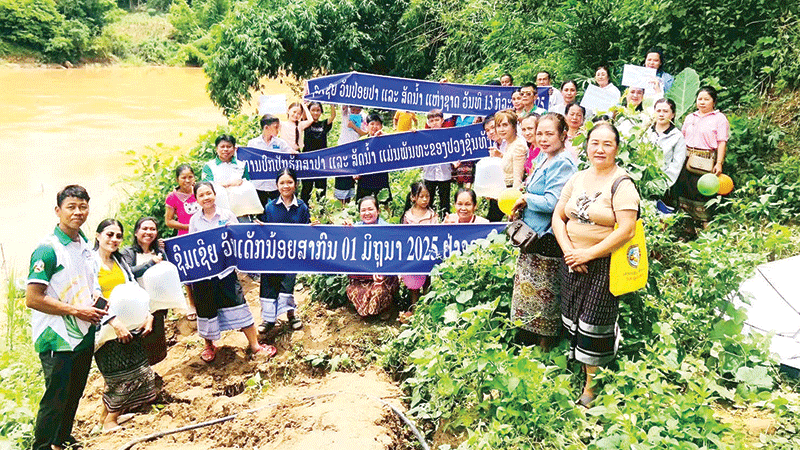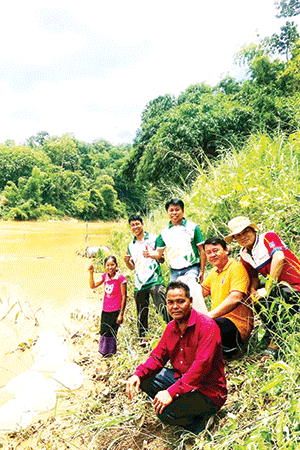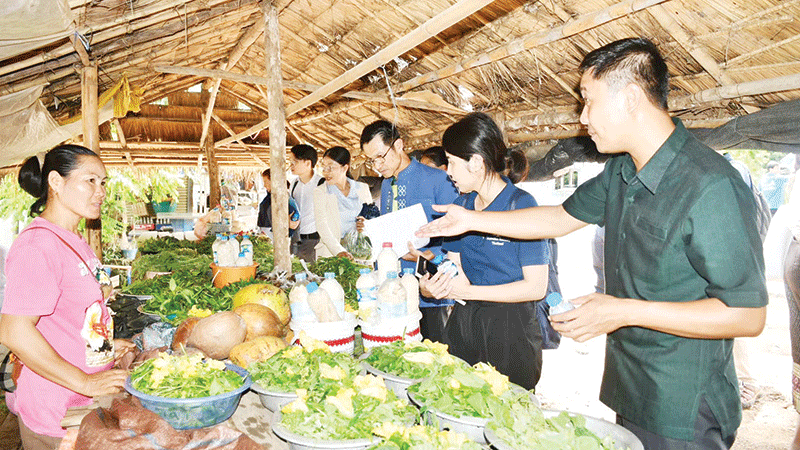 |
| The project team, local residents and authorities gather for the project closing ceremony. |
Luang Prabang villagers join forces in sustainable fisheries management
Following a heartwarming demonstration of community spirit and environmental stewardship, a year-long project to build community capacity in the management of fisheries under the impact of climate change came to a close in August.
The closing ceremony was the culmination of a collaborative effort between the Northern Agricultural and Forestry College at Mae Cho University in Thailand and Souphanouvong University in Laos, together with the Livestock and Fisheries Sector of the Luang Prabang provincial Agriculture and Environment Department.
Under the venture, a fish conservation zone was created in the Xuang River in Viengsavanh village, Luang Prabang. The overall aim of the project was to encourage village residents to manage their fish stocks sustainably, while also promoting alternative livelihoods and easing the harmful impacts of climate change.
 |
| Fingerlings are released into the fish conservation area. |
Over the past year, the community came together to establish the “Vang sa nguan”, protecting fish breeding grounds and fostering sustainable fisheries management.
 |
| Fingerlings are released into the fish conservation area. |
The project also introduced alternative livelihoods, such as processing fish and bamboo shoots, to reduce direct fishing and promote economic stability.
The empowerment of women and future generations was a key focus of the project, aiming to include more women and members of smaller ethnic groups in decision-making and resource management.
The project also instilled a sense of responsibility in children and students, teaching them about the importance of resource conservation for future sustainability.
As the project came to a close, the residents of Viengsavanh village expressed their committment to continuing their efforts in sustainable fisheries management and environmental conservation.
The project’s success is a testament to the power of community-driven initiatives and the importance of collaboration and support from government agencies, international organisations, and local stakeholders.
As the villagers look to the future, they are confident that their efforts will ensure the long-term sustainability of their fisheries resources and the well-being of their community.
The closing ceremony was attended by dignitaries from government agencies, international organisations, and the Australian Department of Foreign Affairs and Trade, and the Asean Global Environment Facility, the project’s funders.
The event featured presentations on the project’s achievements and challenges, as well as a video showcasing changes in traditional livelihoods in Viengsavanh village. Participants visited the fish feeding area, the project product site, and the Viengsavanh village market, witnessing the impacts of the project firsthand.
The fish conservation area runs along a 465-metre section of the Xuang River in Viengsavanh village. It is situated about 20 kilometres from the nearest town and is home to 113 families comprising 607 people, most of whom are smallholder farmers.
At the closing event, village head Mr Somsanith Chanthavong said the villagers’ way of life is closely related to fishing but they struggled to bring in a decent catch after many fish species disappeared from the river.
Consequently, he, together with the villagers as a community, applied to create a fish conservation zone in the village before other species of acquatic creatures also went missing.
“We now have a fish conservation zone stretching over 465 metres, where all aquatic creatures can stay safe and breed. But most importantly, the villagers now understand the importance of aquatic life. They are better informed about which fish it is illegal to catch and are keen to protect them,” Mr Somsanith said.
Vice Dean for Academic Affairs and the Academic Services Faculty of Fisheries Technology and Aquatic Resources at Maejo University, Dr Khajornkiat Srinuansom, said the project had three main aims.
Firstly, to teach local people how to manage their fisheries resources sustainably, while also recommending alternative livelihoods and reducing the impact of climate change. Villagers learnt about the best times to fish and when not to fish because, with climate change, fish might breed earlier of later than usual, so people must be aware of when not to fish.
 |
| A project team visits a local market to observe villagers at work. |
Secondly, the project encouraged villagers to comply with and improve the rules around protecting the fish conservation zone, as full community cooperation, support and understanding of the rules is essential for the success of the initiative.
Lastly, the project introduced alternative livelihoods, such as processing fish and bamboo shoots, to reduce direct fishing and promote economic stability.
Most protection projects affect people’s lifestyle because they rely on the the money they earn from the sale of the fish they catch and the animals they hunt, so alternative ways of earning a living need to be adopted.
Assistant Professor Dr Tinoy Silidxay said gender equality was one important focus that the project never lost sight of.
 |
| Villagers learn to process fish and bamboo shoots for sale. |
Project staff were careful to ensure that everyone, including children and elderly people, shared in all conservation activities.
Workshops were held about community leadership and gender equality, with attendees including people with disabilities and members of smaller ethnic groups, so that everyone participated in decision making and receive shared benefits.
Schoolchildren were also taught about the importance of fish conservation through quizzes and the addition of fingerlings to the river to replenish stocks.
Head of the Women’s Union at the Northern Agriculture and Forestry College, Ms Chanthaphone Phondala, explained the possibilites for alternative livelihoods to the villagers.
Two training sessions were given on the processing of fish, pork and bamboo shoots for sale, which are viable ways to earn an imcome because these products are readily available locally.
“After the training we are now working more closely together and have set up a group to process fish, pork and bamboo products. Some people are doing this to earn an income for the village as a whole,” local resident Miss Noy Chandala said.
Another villager, Mr Khamsing Chuangphanch, now aged 50, said he grew up in the village and loved catching fish. There used to be a lot of fish, especially around breeding time. He and his friends sometimes used illegal devices because they didn’t realise the long-term impact they could have on fish and other aquatic creatures, but now they see that there aren’t enough fish and that many species have disappeared altogether.
But now they understand the situation, the need to comply with the regulations around fishing, and the importance of fish conversation areas.
The Mekong River flows through Laos for nearly 1,900 kilometres, making it the country’s widest and largest river. It serves as a vital source of livelihood, culture, and biodiversity for the Lao people.
The Xuang is a small river that flows into the Mekong and the fish conversation zone it now contains is 300-400 hundred metres from the Mekong.
By Patithin Phetmeuangphuan
(Latest Update November 11, 2025)
|






